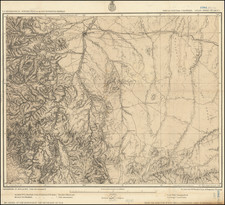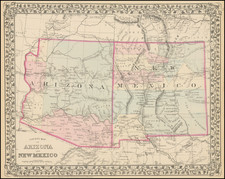Charting An Early Overland Trip To San Diego, 1824-28
Intersting historical map showing "The Final Routes Traveled by Sylvester Pattie from Santa Fe to San Diego, 1824-1828," intended for inclusion in Brand Book Number 7 by the San Diego Corral of The Westerners.
The map, based on the research of Greta Ezell and accompanying her article "The Final Road to Alien Soil," showcases the cartography skills of Richard K. Smith. The detailed map charts the journey of Sylvester Pattie, a pioneering American frontiersman, highlighting significant routes and locations across the southwestern United States from Santa Fe, New Mexico, to San Diego, California.
The map is surrounded by a series of illustrations derived from the lithographs of B.C. Graham, originally published in the 1848 documents of the Thirtieth Congress, which detailed a military reconnaissance from Fort Leavenworth, Missouri, to San Diego, California. These images, numbering seventeen in total, depict various aspects of the landscape, indigenous peoples, flora, and historical landmarks encountered along Pattie’s route. Key illustrations include views of the Copper Mine near Silver City, ruins of the Pecos Catholic Church, the Casa Grande ruins, and the natural flora such as the Cereus giganteus cactus, contributing to a deeper understanding of the terrain and cultural context of the area during this period.
The map itself is marked by significant natural features such as rivers, mountain ranges, and valleys, traced by Pattie’s journey through the rugged terrain of the early American Southwest. Notable are the paths alongside the Gila and Colorado Rivers, illustrating the harsh and varied landscapes traversed. The inclusion of indigenous territories and settlements provides insight into the cultural geography of the region during the 1820s.
This map serves not only as a geographical document but also as an educational tool, illustrating the complexities of historical travel, the challenges of the terrain, and the rich cultural tapestry of the American Southwest in the early 19th century. Its place in Brand Book Number 7 signifies its contribution to the broader collection of historical records and narratives cherished by The Westerners, a group dedicated to preserving the rich history of the American West.
Sylvester Pattie
Sylvester Pattie represents a less celebrated, yet historically significant, figure in the narrative of American westward expansion. Born on August 25, 1782, at Craig's Station, Kentucky, Pattie's early years were marked by the turbulent aftermath of the Revolutionary War. His father, John Pattie, was a participant in the frontier skirmishes, notably involved in the aftermath of the Battle of Blue Licks. Sylvester was educated at Bracken Academy, Kentucky, laying a foundation that would serve him in his varied roles as landowner, mill builder, and frontiersman.
By 1802, Pattie had established himself as a prosperous landowner, marrying Polly Hubbard and fathering nine children, starting with James Pattie. His migration westward began with a move to St. Charles, Missouri, in 1811, where he engaged in constructing mills along the Big Piney River. However, the death of his wife in 1822 from tuberculosis marked a turning point, leading to his subsequent adventures in the West with his son, James.
The father-son duo's ventures took them through various regions, including trapping along the Gila and Colorado rivers and attempting copper mining in Santa Rita, New Mexico. Their journey culminated in California, where they were imprisoned by Mexican authorities under the suspicion of espionage. Sylvester Pattie died in prison in San Diego on May 24, 1828, his death marking the end of an arduous journey through the American frontier.
The Pattie Party's expedition is notable for its timing and route, setting out from Santa Fe in 1827 and reaching the junctions of the Colorado and Gila rivers by December of that year. The group's encounter with the Yuman Indians and their subsequent arrest by Governor Jose de Maria Echeandia highlight the complex interactions between American frontiersmen and the Mexican authorities in California.









![[ Southern California Tourism ] Hunting and Fishing in Southern California on the Santa Fe](https://storage.googleapis.com/raremaps/img/small/101613.jpg)
![[ New Mexico - West Texas ] Estacaco Plain (406) World Aeronautical Chart](https://storage.googleapis.com/raremaps/img/small/96896.jpg)

![[Mexico and Central America with Baja California inset, from Generalkarte von Nord America samt den Westindischen Inseln Versasst von Herrn. Pownall . . . MDCCLXXXVIII]](https://storage.googleapis.com/raremaps/img/small/95064.jpg)

![[ Cabo San Lucas, Southern Baja ] Delineatio Nova Et Vera Partis Australis Novi Mexici, cum Australi Parte Insulae Californiae Saeculo Priori ab Hispnis Detectae.](https://storage.googleapis.com/raremaps/img/small/95666.jpg)